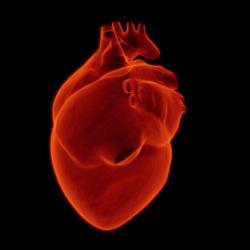In a study published in Communications Biology, they used this system to show that an experimental peptide drug called DX600 can prevent the virus entering the heart cells.
The heart is one the major organs damaged by infection with SARS-CoV-2, particularly the heart cells, or ‘cardiomyocytes’, which contract and circulate blood. It is also thought that damage to heart cells may contribute to the symptoms of long COVID.
Patients with underlying heart problems are more than four times as likely to die from COVID-19, the disease caused by SARS-CoV-2 infection. The case fatality rate in patients with COVID-19 rises from 2.3% to 10.5% in these individuals.
To gain entry into our cells, SARS-CoV-2 hijacks a protein on the surface of the cells, a receptor known as ACE2. Spike proteins on the surface of SARS-CoV-2 – which give it its characteristic ‘corona’-like appearance – bind to ACE2. Both the spike protein and ACE2 are then cleaved, allowing genetic material from the virus to enter the host cell. The virus manipulates the host cell’s machinery to allow itself to replicate and spread.
A team of scientists at the University of Cambridge has used human embryonic stem cells to grow clusters of heart cells in the lab and shown that these cells mimic the behaviour of the cells in the body, beating as if to pump blood. Crucially, these model heart cells also contained the key components necessary for SARS-CoV-2 infection – in particular, the ACE2 receptor.
Working in special biosafety laboratories and using a safer, modified synthetic (‘pseudotyped’) virus decorated with the SARS-CoV-2 spike protein, the team mimicked how the virus infects the heart cells. They then used this model to screen for potential drugs to block infection.
Dr Sanjay Sinha from the Wellcome-MRC Cambridge Stem Cell Institute said: “Using stem cells, we’ve managed to create a model which, in many ways, behaves just like a heart does, beating in rhythm. This has allowed us to look at how the coronavirus infects cells and, importantly, helps us screen possible drugs that might prevent damage to the heart.”
Watch a video and read the full story
Image: Heart
Credit: sbtlneet
Reproduced courtesy of the University of Cambridge
